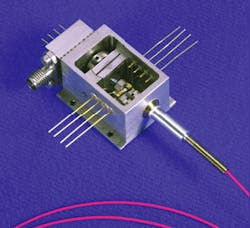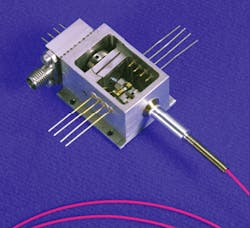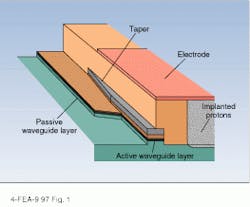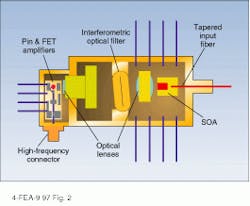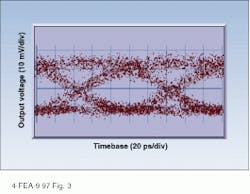Optical preamplification boosts receiver performance
Optical preamplification boosts receiver performance
Semiconductor
optical-amplifier-based
photoreceiver module enables 10-Gbit/s
long-haul data
transmission without erbium-doped fiber amplifiers or dispersion compensation.
T. Ducellier, M. Goix, J. P. Hubert, and S. Artigaud
The development of new broadband services, such as multimedia, video-on-demand, video conferencing, and ultrafast Internet access is driving the need for high-volume networks. Fiberoptic networks can provide this capability over long transmission distances, but high-sensitivity photoreceivers running at very high bit rates are required. Optical preamplification can solve this problem because it allows the separate optimization of the noise performance, which is mainly limited by the noise of the optical amplifier, and of the speed of the receiver, which is given by the photodiode bandwidth.
The most popular approach to optical amplification in the 1.55-µm telecommunication window is based on erbium-doped fiber amplifiers (EDFAs). These devices have very good sensitivities: the best report is around
-40-dBm input power at a rate of 10 Gbit/s for 10-9 bit error rate (BER).1 This sensitivity is a large improvement over the best photodiode-transistor sensitivity of
-23.5 dBm and the record avalanche-photodiode sensitivity of -29.4 dBm reported recently at the same bit rate.2,3 The EDFA configuration, however, is rather bulky, expensive, and complex, often including two amplifying stages. At Alcatel (Marcoussis, France) we have developed an ultracompact, low-power preamplified photoreceiver module based on a 1.55-µm bulk indium gallium arsenide phosphide (InGaAsP) semiconductor optical amplifier (SOA) that demonstrates a sensitivity of -31.4 dBm at 10 Gbit/s (see photo).
Optimization
With nonpreamplified photoreceivers, such as standard photodiodes, the limit in sensitivity is mainly due to the thermal noise of receiver electronics. When a signal is optically preamplified, the optical noise becomes dominant because the optical power impinging on the photodiode is high. But because the quantum limit of optical noise is lower than that of
thermal noise, optically preamplified receivers can achieve higher sensitivities.
The three main sources of optical noise are shot noise, noise coming from beats between the signal and the spontaneous emission of the amplifier, and noise arising from beats of the spontaneous emission with itself. This spontaneous-spontaneous beat noise can be partially removed by narrow optical filtering. The signal-spontaneous beat noise is fixed by the data bandwidth. Thus the only way to improve the receiver sensitivity is to lower the spontaneous emission of the amplifier by achieving total population inversion.
In an EDFA, this is efficiently obtained through 980-nm optical pumping and is the reason why EDFA preamplifiers lead to extremely good sensitivities. In an SOA, only partial inversion is achieved, and the population inversion is described by the inversion parameter nsp. By specially designing the active layer composition and geometry, it is possible to lower this parameter from typically 5 dB to around 2 dB, with 0 dB corresponding to perfect inversion. In our case, we used a short bulk-gain region, with low tensile strain to achieve polarization insensitivity.4
Another important parameter for optically preamplified receivers is coupling loss from the input fiber to the optical amplifier. At a given noise power level, a decrease in input coupling loss leads to an increase in the optical signal-to-noise ratio, improving receiver sensitivity. In an EDFA, there is minimal coupling loss of only a few tenths of a decibel where the input fiber is spliced to the erbium-doped fiber, whereas typical coupling losses for a semiconductor component range from 3 to
5 dB. In our case, the mode adapters were designed to efficiently couple
the light in and out of the SOA. Estimated losses are less than 2.5 dB with bulk optics because the adapters use tapers based on a double-core configuration (see Fig. 1).5 In this arrangement, the upper active layer decreases in width from approximately 1 µm to zero, while the lower passive stripe increases from 1 µm to 3 µm.
In this tapered transition region, the optical mode goes from the upper layer down to the passive layer in a smooth adiabatic way, resulting in very low additional losses. The passive waveguide eigenmode is circular, with a diameter of around 3 µm. Some magnification is therefore needed in coupling to a single-mode fiber (typical diameter around
10 µm). A tapered lensed fiber at the input and a twin-lens optical system at the output provide the magnification.
Module fabrication
The compact preamplified photoreceiver module includes a high-performance low-noise SOA, an interferometric optical filter for removing the spontaneous-spontaneous beat noise, a fast photodiode, and a transimpedance electrical amplifier (see Fig. 2). The two lenses in the optical system at the SOA output collimate the beam, allowing insertion of an optical filter. All elements are antireflection-coated and tilted with repect to the optical axis to avoid parasitic backreflection. The filter angle is adjustable to tune the operating wavelength. The assembly is dynamically aligned--that is, the performance of the module is monitored when assembled and then Nd:YAG-laser-welded once in the optimum position.
The optimized SOA shows a very high fiber-to-fiber gain of 29 dB, together with a low noise factor of about 7 dB, which is only 4 dB more than the quantum limit. The measured fiber sensitivity of the module at 10 Gbit/s is -31.4 dBm for a 10-9 BER. At this mean optical input power level, the electrical output of the module is about 25 mV peak to peak on 50 W, and there is no evidence of distortion on the eye diagram (see Fig. 3). The ultimate sensitivity is theoretically around
-33.5 dBm at 10-9 BER. The discrepancy with the measured value is attributed to nonoptimal optical filtering and nonoptimal coupling of the optical beam to the
photodiode.
The module is very compact--approximately 2 cm3--similar in size to a nonpreamplified receiver. Power consumption is only 270 mW (135 mA/2 V) for the SOA and 80 mW (13 mA/5 V) for the transimpedance electronics. An interesting characteristic of the receiver is the ability to electrically adjust the preamplification gain. The electrical response of the SOA is very fast, on the order of 200 ps, compared to a few milliseconds for an EDFA, and it is therefore possible to build an automatic gain-control loop to maintain constant receiver performance independent of the signal input power. Thus a receiver with such a control loop can have limitless dynamic range.
Because of the receiver-module sensitivity, it is possible to demonstrate
10-Gbit/s transmission without erbium-doped fiber amplifiers, a cost-effective solution for terrestrial optical transmissions. We have successfully tested
10-Gbit/s transmission on standard G.652 fiber (single-mode and dispersive at 1.55 µm) over a distance of 80 km without an EDFA or dispersion compensation. The transmitter consisted of a CW laser externally modulated at 10 Gbit/s with a push-pull-driven lithium niobate Mach-Zehnder modulator. The launched power was -5 dBm. Insertion of the
80-km section of single-mode fiber resulted in 17-dB induced losses and 1360 ps/nm chromatic dispersion. Measured fiber sensitivity, including isolator losses, was -29 dBm, leaving a large system margin of more than 7 dB. o
ACKNOWLEDGMENTS
Part of this work is supported by the European Commission under ACTS/HIGHWAY contract. Thanks to O. Legouezigou, R. N`Go, F. Pommereau, N. Tscherptner, J. Pasquier, F. Gaborit, and P. Pagnod from Alcatel Alsthom for their work in developing the SOA. Thanks also to P. Blanconnier from CNET, Bagneux, France, for developing the high-speed photodiode.
REFERENCES
1. J. C. Livas, OFC` 96, San Jose, CA, paper PD4.
2. T. Y. Yun, J. H. Han, and M. S. Park, Electron. Lett. 31(19), 1688 (1995).
3. T. Y. Yun et al., ECOC `96, Oslo, Norway, paper ThC.1.5.
4. T. Ducellier et al., ECOC `96, Oslo, Norway, paper WeD.2.5.
5. P. Doussière et al., ECOC `96, Oslo, Norway, paper WeD.2.4.
Semiconductor optical amplifier in photoreceiver module allows 10 Gbit/s transmission over 80 km of single-mode fiber with high sensitivity without EDFAs or dispersion compensation. The 2-cm3 module consumes only 350 mW of total power.
FIGURE 1. Tapered active layer in semiconductor optical amplifier permits optical mode to smoothly transition to passive layer.
FIGURE 2. Preamplifier two-lens arrangement allows insertion and angle tuning of optical filter while still providing efficient coupling to the
photodiode. A field-effect-transistor (FET) amplifier boosts the detected signal up to 25 mV peak to peak.
FIGURE 3. Photoreceiver output-voltage eye diagram exhibits no signal distortion at -31.4-dBm mean optical input power.
T. DUCELLIER is project leader, M. GOIX is a technician, and J. P. HÉBERT and S. ARTIGAUD are research engineers at the Alcatel Alsthom Corporate Research Center, Route de Nozay, F-91460 Marcoussis, France.
